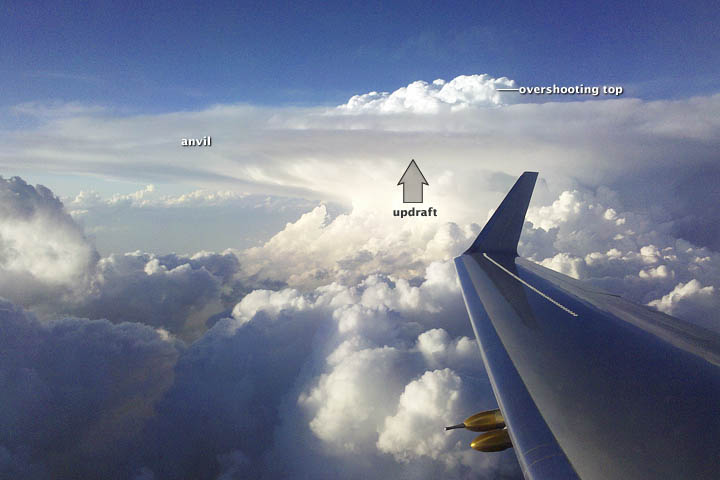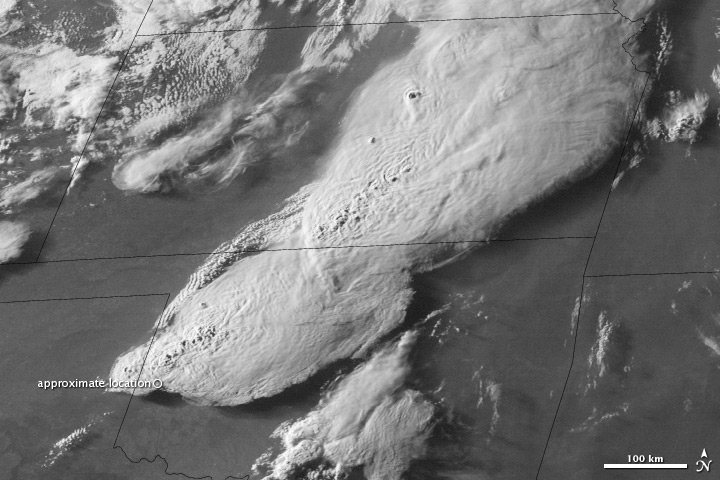
acquired May 19, 2012
download large image (995 KB, JPEG, 2592x1936)

acquired May 19, 2012
download large image (490 KB, JPEG, 1199x1419)
Researchers on NASA’s DC-8, a flying laboratory,
have launched a six-week hunt for thunderstorms. They’re part of a team
of 100 researchers from 29 organizations participating in Deep Convective Clouds and Chemistry
(DC3), a field campaign based in Kansas sending aircraft to Alabama,
Colorado, and Oklahoma to sample how storms affect the chemistry of the
upper troposphere.
The preferred target: large multicell and supercell storms
with powerful updrafts capable of lofting volatile pollutants and
moisture-rich air nearly 12,000 meters (40,000 feet) up in the
atmosphere, a height that pollutants wouldn’t reach without a boost from
a storm. They are particularly interested in understanding how certain
pollutants react with nitrogen oxides produced by lightning to generate ozone, a greenhouse gas that has a strong impact on the climate at this altitude.
Four days into the campaign, the researchers found just the sort of
storm they were looking for developing southwest of Cheyenne over
central Oklahoma. According to a summary of the flight posted on the campaign's website,
the storm cell formed rapidly around 5:00 p.m., and by 5:45 p.m. the
DC-8 and the National Center for Atmospheric Research and National
Science Foundation’s Gulfstream-V had reached the storm's southern edge and started taking samples.
The image above, a photograph taken by DC3 Principal Investigator Chris Cantrell as the Gulfstream-V was approaching from the south, shows the structure of the storm cloud. Vigorous convection
has created a strong updraft near the center of the storm where warm,
moist air rises quickly upward, sometimes at speeds up to 160 kilometers
per hour (100 miles per hour).
The flat bank of cirrus clouds spreading outward and forming the cloud’s anvil mark the edge of the tropopause.
The tropopause is the boundary between the lowest layer of the
atmosphere where most weather occurs and air often flows vertically (the troposphere) and a higher layer where air flow is mainly horizontal (the stratosphere).
The tropopause behaves like a wall, deflecting the updraft's rising
air and causing it to spread outward in a way that molds the upper part
of clouds into the distinctive anvil shape. However, convection
sometimes pushes moisture past the top of the cloud and into the
tropopause, creating bubbling protrusions called overshooting tops. These protrusions are usually short lived and wispy, but they tend to persist longer above severe storms like this one.
While the DC-8 was at a low altitude measuring air flowing into the
storm, the Gulfstream-V measured the outflow near the top of the storm.
The plane made two passes directly though the anvil and one above it.
The instruments on the Gulfstream-V detected elevated levels of carbon
monoxide and methane near the top of the storm, suggesting the updraft
had lofted pollutants from the surface high into the atmosphere.
Instruments on the DC-8, meanwhile, detected high levels of aerosols entering the storm, possibly smoke that had wafted to the area from fires in Mexico.
As the aircraft were sampling the storm, satellites were observing
the broader scene from above. An imager on the geostationary GOES-East
satellite captured the lower image at 7:15 p.m. on May 19, 2012. It
shows the storm front stretching across Oklahoma and into Kansas. The
dark specks that give texture to the front are overshooting tops. The
approximate location of the aircraft when it observed the storm is
marked with a circle.
References
- NASA. (2012). DC3: Chemistry of Thunderstorms. Accessed May 25, 2012.
- NOAA. (2012). NOAA, Partners Kick Off Multi-State Study of How Thunderstorms Affect Upper Atmosphere. Accessed May 25, 2012.
- Barth, Mary. (2010). Scientific Program Overview for a Deep Convective Clouds and Chemistry Field Campaign (pdf). Accessed May 25, 2012.
Photograph courtesy of the DC3 team. NASA Earth Observatory image by Robert Simmon using data provided by the GOES team. Caption by Adam Voiland.
- Instrument:
- Photograph
Ricardo M Marcenaro - Facebook
Operative blogs of The Solitary Dog:
solitary dog sculptor:
http://byricardomarcenaro.blogspot.com
Solitary Dog Sculptor I:
http://byricardomarcenaroi.blogspot.com
Para:
comunicarse conmigo,
enviar materiales para publicar,
propuestas:
marcenaroescultor@gmail.com
For:
contact me,
submit materials for publication,
proposals:
marcenaroescultor@gmail.com
Diario La Nación
Argentina
Cuenta Comentarista en el Foro:
Capiscum
My blogs are an open house to all cultures, religions and countries. Be a follower if you like it, with this action you are building a new culture of tolerance, open mind and heart for peace, love and human respect.
Thanks :)
Mis blogs son una casa abierta a todas las culturas, religiones y países. Se un seguidor si quieres, con esta acción usted está construyendo una nueva cultura de la tolerancia, la mente y el corazón abiertos para la paz, el amor y el respeto humano.
Gracias :)

